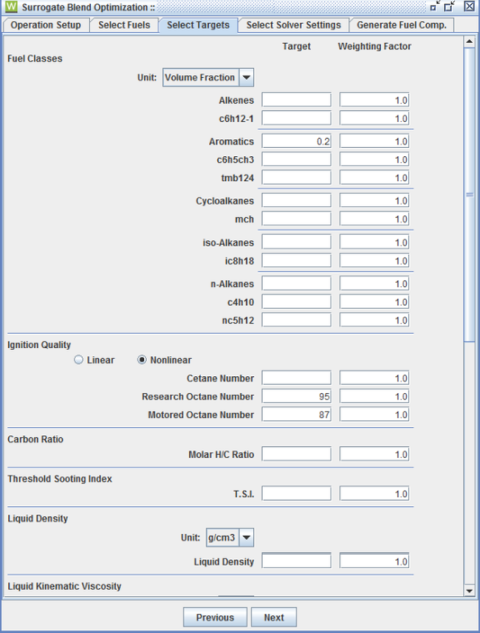Multi-component mechanisms for diesel and gasoline included with Ansys Forte are reduced from the full mechanisms for specific blends. They can readily be used for different blends with the same components to represent fuels with different characteristics. Using the Surrogate Blend Optimizer tool in Ansys Chemkin Reaction Workbench can help in creating the best surrogate blend to match the important known properties of the test fuel. It can create multi-component surrogates ranging from two-component to much more complex versions, to match one or more properties, including:
Octane or Cetane numbers
certain component specifications
elemental H/C ratio
density
viscosity
heating value
Reid vapor pressure
distillation curve
A screenshot of the tool’s Targets specification tab to specify the known properties of the test fuel is shown in Figure 3.1: Example of Surrogate Blend Optimizer in Ansys Chemkin Reaction Workbench. Specification of test fuel properties, called Targets, is shown.
For example, the goal is to obtain a surrogate for a gasoline with a lower percentage of aromatics and similar ignition quality as that used in the gasoline_7-comp chemistry set. We can use the same mechanism as an input to the Surrogate Blend Optimizer to identify the component options available in the mechanism. Any one or more known properties of the real fuel can be used as Targets. Here, the aromatics fraction is set to 0.2 to have 20 vol.% total aromatics in the blend. In addition, RON and MON of 95 and 87, respectively, are used as targets, as shown in Figure 3.1: Example of Surrogate Blend Optimizer in Ansys Chemkin Reaction Workbench. Specification of test fuel properties, called Targets, is shown. An optimized composition including 7 components will be generated that will match those targets. If additional properties are available, they can be used as targets, if necessary.
Figure 3.1: Example of Surrogate Blend Optimizer in Ansys Chemkin Reaction Workbench. Specification of test fuel properties, called Targets, is shown

In general, the pre-reduced mechanisms can be used without additional validation if the following are true:
Percentage of any component in the desired surrogate is within 20% of the original surrogate for which the mechanism has been reduced.
If the desired octane or cetane numbers are within 20 numbers of those of the original surrogate.
More information about the Surrogate Blend Optimizer and model-fuel mixtures is available in the Chemkin Reaction Workbench User's Manual and an example, the Surrogate Blend Optimizer (SBO) tutorial, in the Reaction Workbench Tutorial Guide.

